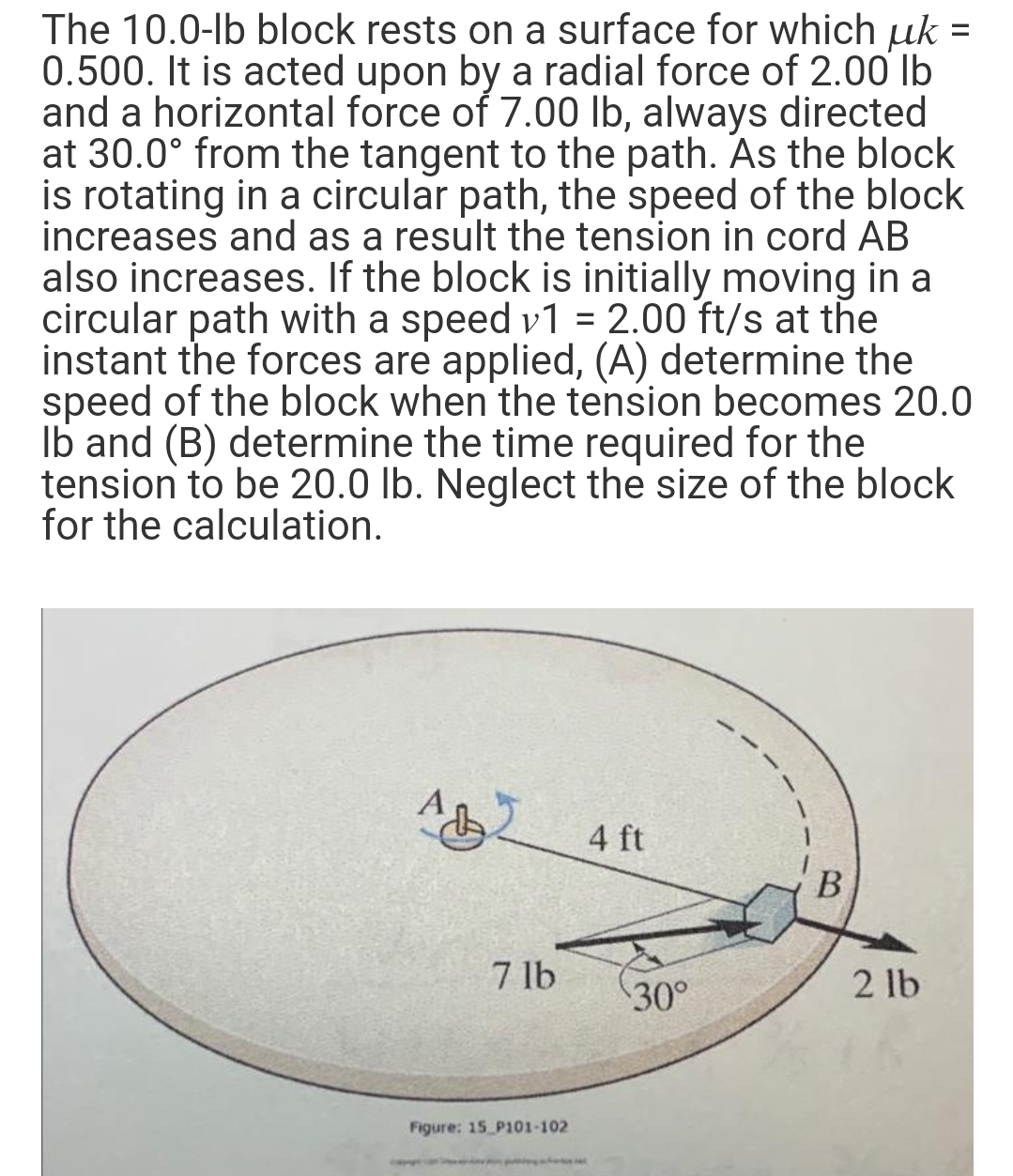The 10.0-lb block rests on a surface for which uk = 0.500. It is acted upon by a radial force of 2.00 lb and a horizontal force of 7.00 lb, always directed at 30.0° from the tangent to the path. As the block is rotating in a circular path, the speed of the block increases and as a result the tension in cord AB also increases. If the block is initially moving in a circular path with a speed v1 = 2.00 ft/s at the instant the forces are applied, (A) determine the speed of the block when the tension becomes 20.0
The 10.0-lb block rests on a surface for which uk = 0.500. It is acted upon by a radial force of 2.00 lb and a horizontal force of 7.00 lb, always directed at 30.0° from the tangent to the path. As the block is rotating in a circular path, the speed of the block increases and as a result the tension in cord AB also increases. If the block is initially moving in a circular path with a speed v1 = 2.00 ft/s at the instant the forces are applied, (A) determine the speed of the block when the tension becomes 20.0
Elements Of Electromagnetics
7th Edition
ISBN:9780190698614
Author:Sadiku, Matthew N. O.
Publisher:Sadiku, Matthew N. O.
ChapterMA: Math Assessment
Section: Chapter Questions
Problem 1.1MA
Related questions
Question

Transcribed Image Text:The 10.0-lb block rests on a surface for which µk =
0.500. It is acted upon by a radial force of 2.00 lb
and a horizontal force of 7.00 lb, always directed
at 30.0° from the tangent to the path. As the block
is rotating in a circular path, the speed of the block
increases and as a result the tension in cord AB
also increases. If the block is initially moving in a
circular path with a speed v1 = 2.00 ft/s at the
instant the forces are applied, (A) determine the
speed of the block when the tension becomes 20.0
Ib and (B) determine the time required for the
tension to be 20.0 lb. Neglect the size of the block
for the calculation.
4 ft
В
7 lb
30°
2 lb
Figure: 15 P101-102
ww nd
Expert Solution
This question has been solved!
Explore an expertly crafted, step-by-step solution for a thorough understanding of key concepts.
This is a popular solution!
Trending now
This is a popular solution!
Step by step
Solved in 3 steps with 3 images

Knowledge Booster
Learn more about
Need a deep-dive on the concept behind this application? Look no further. Learn more about this topic, mechanical-engineering and related others by exploring similar questions and additional content below.Recommended textbooks for you

Elements Of Electromagnetics
Mechanical Engineering
ISBN:
9780190698614
Author:
Sadiku, Matthew N. O.
Publisher:
Oxford University Press

Mechanics of Materials (10th Edition)
Mechanical Engineering
ISBN:
9780134319650
Author:
Russell C. Hibbeler
Publisher:
PEARSON

Thermodynamics: An Engineering Approach
Mechanical Engineering
ISBN:
9781259822674
Author:
Yunus A. Cengel Dr., Michael A. Boles
Publisher:
McGraw-Hill Education

Elements Of Electromagnetics
Mechanical Engineering
ISBN:
9780190698614
Author:
Sadiku, Matthew N. O.
Publisher:
Oxford University Press

Mechanics of Materials (10th Edition)
Mechanical Engineering
ISBN:
9780134319650
Author:
Russell C. Hibbeler
Publisher:
PEARSON

Thermodynamics: An Engineering Approach
Mechanical Engineering
ISBN:
9781259822674
Author:
Yunus A. Cengel Dr., Michael A. Boles
Publisher:
McGraw-Hill Education

Control Systems Engineering
Mechanical Engineering
ISBN:
9781118170519
Author:
Norman S. Nise
Publisher:
WILEY

Mechanics of Materials (MindTap Course List)
Mechanical Engineering
ISBN:
9781337093347
Author:
Barry J. Goodno, James M. Gere
Publisher:
Cengage Learning

Engineering Mechanics: Statics
Mechanical Engineering
ISBN:
9781118807330
Author:
James L. Meriam, L. G. Kraige, J. N. Bolton
Publisher:
WILEY